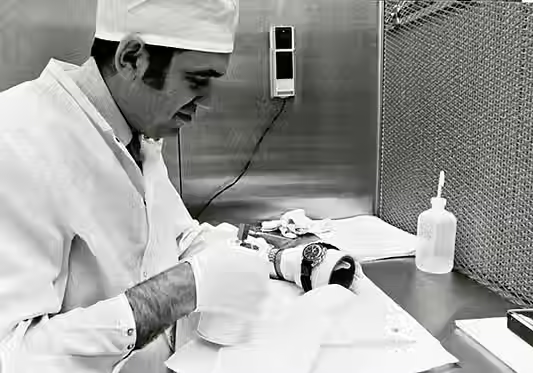top of page


A Lunar Legacy: How the Speedmaster Became the Moonwatch
Omega is revered for it's high-performance ability which has been cameoed in several films such as Dunkirk and James Bond. More groundbreaking, due to its contributions in several NASA operations, few timepieces carry the historical and technological impact as the Omega Speedmaster.
Having served as the official timekeeper for both the Olympic Games and the British Royal Flying Corps, Omega has long been known for its durability and athletic precision since its founding in 1903. While the brand has served as an essential tool in impactful moments throughout history––for instance, World War II––perhaps one of its greatest contributions in recent history is its role in producing the first watch worn on the moon: the Omega Speedmaster.

A Brief History
The first Speedmaster reference was the CK2915 created in 1957 as a part of Omega’s Professionalism series, alongside the Seamaster and the Railmaster. It was not originally intended to be used in space missions, but rather motorsport timing and other athletics. As the first chronograph to feature the tachymeter on the bezel instead of the dial, the Speedmaster impacted the entire horological industry, influencing other major competitors like Rolex and Heuer to follow suit. This new feature allowed for the accurate measure of speed while still having a full display of the main clock. Later references of the watch were equally revolutionary and included upgrades such as a waterproof caseback and stainless steel bezel, however later iterations of the 2915 featured a black aluminum bezel which would later become iconic to more modern references.
As the Speedmaster evolved with every version, its usages evolved as well from sports to space. When Walter Schirra donned his watch during the Sigma 7 mission in 1962, the CK 2998 became the first Speedmaster worn in space, and is a preview of the lunar legacy that would soon follow.
Omega Beats Rolex in NASA Tests
In 1964, astronauts in the Gemini and Apollo flight crews requested highly durable and efficient chronographs that they could use during training and flights. As a result, NASA sent out requests to over ten different watch brands, however only Omega, Rolex, Longines-Wittnauer, and Hamilton responded, however Hamilton was immediately disqualified.
NASA’s rigorous test requirements included eleven parameters: high-temperature, low-temperature, vacuum, corrosion, shock-resistance, acceleration, low-pressure, high-pressure, vibration, and sound tests. The Rolex test watch failed the humidity test while the Longines watch failed high-temperature test. After they concluded the testing in 1965, the Omega Speedmaster 105.003 was the only tested watch to be qualified for all manned space missions.

1965: The Speedmaster undergoing one of NASA's tests (omegawatches.com)

1965: Walter M. Schirra and Thomas P. Stafford preparing for the Gemini VI mission
Apollo 11 and 13 Missions
The crew of the Apollo 11 mission, Neil Armstrong, Buzz Aldrin, Michael Collins, all wore fourth generation Speedmaster Professional watches. Aldrin’s wore the 105.012 iteration of the Speedmaster, which became the first watch ever worn on the moon once he stepped foot on its surface. Armstrong took his Speedmaster off before stepping on the moon, which is why even though he is famously known as the first man on the moon, his Speedmaster 105.012-65 was not given the same title.
A year later, in the Apollo 13 mission, the Speedmaster made history once again by playing a critical role in saving the lives of the flight crew. After oxygen and hydrogen reserve tanks exploded––giving way to the famous quote, “Houston, we have a problem”––Commander Lovell’s Speedmaster was the essential tool in timing when to launch the re-entry rockets in order to safely return the crew to Earth.

Apollo 11 Crew Portrait (nasa.gov)

Apollo 13 Crew Portrait (nasa.gov)
The Omega Speedmaster’s journey from athletics to lunar missions is a testament to its iconic precision, durability, and historical impact. More than just a timepiece, it became a relied-upon instrument in some of humanity’s greatest explorations.
bottom of page